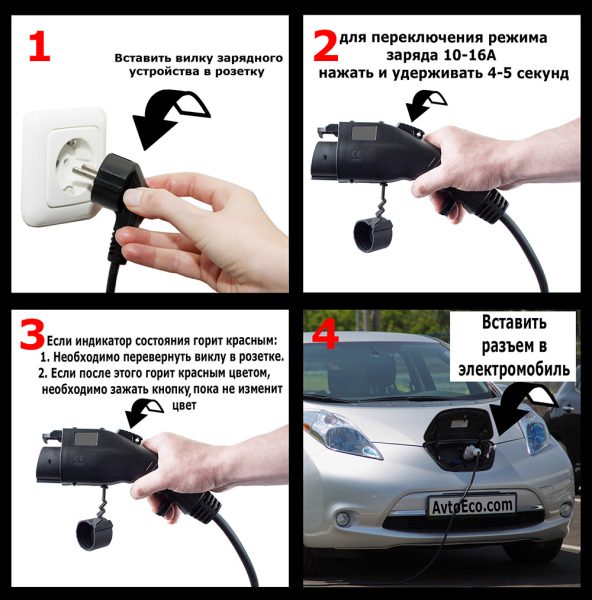
Electric Vehicle Charging Guide
Content
When buying an electric vehicle, it is important to learn about the features of this vehicle, especially when it comes to recharge.
In this article, La Belle Batterie gives you all the information you need to charge your electric vehicle, whether charging. at home, at work or in public terminals.
Types of charging sockets for your electric vehicle
First of all, there are 3 different types of cables:
– Cables for connection to household socket 220 V or enhanced grip Green'up (example: Flexi charger), also called mobile chargers or consumer cables.
– Cables for connection to Home Terminal тип Wallbox or public terminal.
- cable are integrated right in public terminal (especially fast charging stations).
Each cable consists of a part that connects to the electric vehicle and a part that connects to a charging station (wall outlet, home or community terminal). Depending on your vehicle, the socket on the vehicle side may not match. In addition, you must use the correct cable depending on the charging infrastructure chosen.
Car socket
What are you using mobile charger for a classic or reinforced grip, or charging cable the vehicle-side socket for a home or public terminal will depend on your electric vehicle. Those cable can be provided when purchasing a car, but this is not always the case.
Depending on your electric vehicle, you can find the following outlets:
- Enter 1 : Nissan Leaf before 2017, Peugeot iOn, XNUMXst generation Kangoo, Citroën C-zero (this type of fork tends to disappear though)
- Enter 2 : Renault Zoe, Twizy and Kangoo, Tesla model S, Nissan Leaf after 2018, Citroën C-zero, Peugeot iOn or even Mitsubishi iMiEV (this is the most common plug on electric vehicles).
Terminal block
If you are charging your electric vehicle from a household outlet or a power outlet, this is the classic outlet. If you choose to use the cable to charge your vehicle at a household or public charging station, the socket on the side of the charging station will be disconnected. Enter 2 or Type 3c.
For cables directly integrated into public charging stations, you can find either Enter 2, or double CHADeMo, or either a double Combo CCS.
CHAdeMO fork is compatible with Citroën C-zero, Nissan Leaf, Peugeot iOn, Mitsubishi iMiEV and Kia Soul EV. As for the Combo CCS connector, it is compatible with Hyundai Ioniq electric, Volkswagen e-Golf, BMW i3, Opel Ampera-e and Zoe 2019.
To learn more about charging electric vehicles, you can download the charging guide for your electric vehicle created by Avtotachki. There you will find simple information, embellished with practical diagrams to navigate!
Where to charge your electric car?
Home charging
According to Automobile Propre, "home recharging is typically 95% of the recharges performed by the electric vehicle user."
Indeed, all electric vehicles come with a home cable (or Flexi charger), so most motorists charge their vehicle from a home power outlet or a reinforced Green'up outlet, allowing for more power and safety than the classic option. If you also wish to opt for this solution, we strongly recommend that you call a qualified technician to check your electrical installation. An electric vehicle does require a certain amount of power to recharge, and you must make sure that your electrical installation can handle this load and thus avoid the risk of overheating.
Last option for home charging: regular charging station wallbox... Most manufacturers recommend this solution, which is more powerful, faster, but above all, safer for your electrical installation.
However, the cost of a home charging station is between € 500 and € 1200, plus the cost of installation by a professional. However, you can get assistance with setting up your terminal for up to € 300 thanks to a special tax credit.
If you live in a condominium, you also have the option to set up a charging station thanks to the right to a power outlet. However, you must comply with two conditions: notify the property manager of your condominium and install a sub-meter at your own expense to measure your consumption.
You can also choose to implement a collaborative, operator-led solution that will answer all queries. Zeplug, the co-owned electric vehicle charging specialist, brings you a turnkey solution. The company installs an electricity source at its own expense, independent of the building's electricity supply and intended for recharging. Then charging stations are installed in the parking spaces of co-owners or tenants wishing to use the service. Users select one of five charging capacities: 2,2 kW, 3,7 kW, 7,4 kW, 11 kW and 22 kW, and then sign up for a full subscription without any obligation.
In any case, you should choose a charging solution according to your needs and your electric vehicle. You can hire a charging specialist like ChargeGuru to help you choose the best charging solution. ChargeGuru will advise you on the best charging station according to your vehicle and your use, and offer you a complete solution including hardware and installation. You can request a quote, the technical visit is free.
Workplace charging
More and more companies that have parking spaces for their employees are installing charging stations for electric vehicles. If this is the case at your workplace, it may allow you to charge your vehicle during business hours. In most cases, charging is free, which saves money on your home's electricity bills.
For companies not equipped with charging stations, the regulations, as well as some aids, can simplify their installation.
Thus, the law provides for a pre-equipping obligation for new and existing buildings, pending the future installation of charging stations. This is exactly what article R 111-14-3 of the Building Code says: “when in new buildings (after January 1, 2017) a parking lot is equipped for basic or tertiary use, this parking is provided with a specialized electrical circuit for recharging electric vehicles or plug-in hybrids ".
In addition, companies can receive assistance in installing recharging infrastructure, in particular through the ADVENIR program up to 40%. You can also find details in the Avtotachki Guide.
Charging at public charging stations
You can charge your electric car for free in the parking lots of shopping malls, supermarkets, big brands like Ikea, or even at your dealership. You can also use public terminal networks in urban areas and on highways, this time for a fee.
How do I find recharging points?
ChargeMap is a test application. This service, created in 2011, allows you to display charging stations in France and Europe, indicating the working status and types of charging available for each of them. Based on the principle of crowdsourcing, ChargeMap relies on a large community that indicates the status and availability of said terminals. This mobile app also lets you know if the outlets are busy or free.
Payment systems
To have access to multiple charging station networks, we recommend that you purchase an access badge, such as the ChargeMap pass, for € 19,90. Then you will also need to add the cost of recharging, the price of which depends on the network of terminals and their capacity. Here are some examples:
- Corri-door: main fast charging network in France, from 0,5 to 0,7 euros for 5 minutes of charging.
- Bélib: Paris chain: € 0,25 for 15 minutes for the first hour, then € 4 for 15 minutes for badge holders. Calculate € 1 for 15 minutes in the first hour, then € 4 for 15 minutes for people without a badge.
- Autolib: network in Ile-de-France, subscription 120 € / year for unlimited top-ups.
Safety Tips When Charging Your Electric Vehicle
When you charge your electric vehicle at home, in the workplace, or at a public charging station, there are certain safety guidelines you must follow:
– Do not touch or tamper with the vehicle: do not touch the cable or socket on the vehicle side or on the terminal side. Do not wash the vehicle, do not work on the engine, or insert foreign objects into the vehicle's socket.
– Do not touch or tamper with the electrical installation during recharging.
– Do not use an adapter, socket or extension cord, do not use a generator. Do not modify or disassemble the plug or charging cord.
– Regularly check the condition of the plugs and the charging cable (and take good care of it: do not step on it, do not put it in water, etc.)
– If the charging cable, socket or charger is damaged, or struck against the charging hatch cover, contact the manufacturer.
For a better understanding of the various charging methods, we suggest reading the article "Charging an Electric Vehicle".
